My Top 5 Dive Equipment Wish List
I’m Impatient For The Future…
I am a self confessed dive-gadget freak. I love scuba gear because the sea is the ultimate final frontier on Earth, and dive gear designers have some of the most intense challenges in front of them when creating new products. Their goal is to make our time spent underwater more fun, efficient and safe (and to make a hefty profit). The manufacturers clearly succeeded because diving is a surprisingly safe and easy sport, yet the forces and hostility of the environment we spend so much time in is amazing. Dive gear has to endure the abuse of a diver (which is pretty tough in its own right!), the immense pressures of the sea, the corrosion of salt water, the extreme cold and heat on the surface and the shocks of being banged around in a box or dive bag. What really impresses me is that dive gear can withstand all that damage and then proceed to do something extremely cool like calculate how much air I have left in my tank (wireless air transmitters) or propel me through the water at an astonishing rate (super-efficient fins).
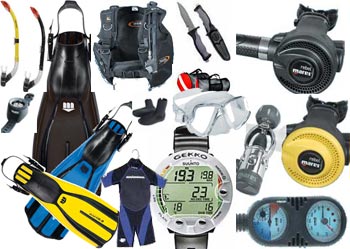
A Whole Set Of Diving Gear That Will Keep Functioning Despite What Either I or The Sea Does To It!
The technology and finesse that is displayed in modern dive equipment is both humbling and exciting, we have answered almost all the major problems with diving on pressurised gas underwater…yet there is always something more isn’t there? I have sat on many dive boats with a whole plethora of divers who have all mulled over the possibility of future dive technologies. Often they are just simple tweaks on old ideas (one idea I heard was “could they fit small DPV style propellers on fins to help you along?”) but usually the conversation comes round to five specific technologies that everyone wants to see. I’ve listed them below with a look at what we have on the market today in that area, and I’ve also let myself dream of what might come in the future…
Effective Underwater GPS
GPS is everywhere; it’s in phones, cars and laptops. I know many people who would rather give up their cars than their GPS units – it’s become that integral in our daily lives. It is obvious why – having a computer decide what route is fastest to your chosen destination is both convenient and timesaving which are the two most important attributes for any modern technology. They are also important aspects of diving because we are on a ticking clock when we go under – air runs out and nitrogen builds up. Getting where we want quickly via the interesting things on the site are the top priorities of any diver.
GPS offers this sort of efficient route planning, but is currently ineffective for underwater adventures because the normal (surface) way of calculating your position doesn’t work – the dense water screws with the signals. There are products on the market at present which require you to place three surface beacons in a triangle around the site to give your computer an idea of where you are, but it counters the efficiency that the GPS is there to provide.
In the future I want a GPS that is wrist mountable and will provide me with exact routes around any dive site. I also want it to take into account tides and currents. It should be able to download great routes from the web so that I other divers can post their favourite dives and label the map with what they saw and where it was. It would be a personal, electronic Divemaster.
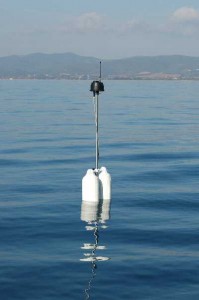
Curent GPS Requires Surface Beacons To Bridge The Transition Between Water And Air – Which Isn’t Nearly As Convenient!
Perfect, Flexible Insulation
There is a constant influx of products onto the exposure suit market which all promise unsurpassed levels of warmth retention and water restriction. They do this using a number of modern materials and a few very clever techniques, however they are either very warm but difficult to move in (though this is being addressed) or flexible but too cool. What we need is a skintight suit with similar properties to lycra (to reduce water movement in the suit) and through the fabric of this suit would be hundreds of tiny superconductive wires that carried heat around the suit from a central heating unit which would clip to the tank or your BCD.
This suit wouldn’t need to be particularly insulating because the warmth would come from the heat box and be dispersed all around the body by these superconductive wires. This might be worn under a very thin wetsuit in extreme situations purely to ensure there weren’t any cold spots.
This isn’t a particularly futuristic idea (except for the part about super conductors – that was straight out of Star Trek) because there are already wetsuits on the market that employ this exact technique – they have heating membranes within the material which actively warm you during your dive. They are still primarily wetsuits, but with a little more material research and design testing we may well come across the super-flexible, power-heated exposure suit in the future.
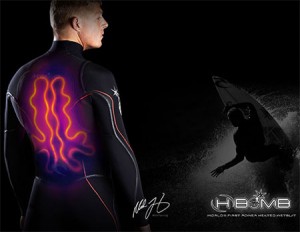
Some New Products In The Wetsuit Market Are Coming With Incorporated Heating Webs.
Infallible, Low-cost Rebreathers
Here’s my personal number one wish for future dive gear. It’s also quite likely to be invented in the not-too-distant future. The reason I predict its imminent arrival is because it is already here in effect, it’s just not sufficiently cheap or simple enough to be a viable option for the average diver.
For those who are unaware of what a rebreather is it is essentially a personal air recycler which takes the air you breath out, scrubs the bad gas away and adds oxygen to it to make it fresh air again. It also works with a dive computer to modify the gas you breath to be more or less oxygen rich to compensate for nitrogen build up. As an added benefit they produce no bubbles which means they don’t scare away fish. It is a Tec diver’s best friend…and worst enemy. Rebreathers have been dangled in front of the dive community for a couple of decades now, yet they are still very complicated machines that require comprehensive training to use and maintain. They are also so unreliable that many Tec divers choose to dive with a full dive’s worth of tanks as well as the rebreather just incase the unit should fail. On top of this they are prohibitively expensive which makes them almost inaccessible to the lay diver.
Cheap, simple and reliable rebreathers will revolutionise SCUBA, but who can say when we’ll get them?
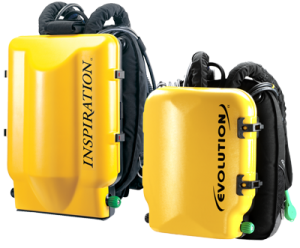
Current Rebreathers Are Awesome Feats of Technology – But They’re Not Cheap Or Simple Enough For The Common Diver.
Breathable Liquid
Hands up; who watched James Cameron’s The Abyss and immediately began to fantasise about having breathable liquid which would remove the worry of pressure related injuries? In the movie the main character must go to a ridiculous depth which is essentially impossible on SCUBA so they use a prototype liquid-breathing apparatus which delivers oxygen to the lungs via liquid rather than by gas which means he can withstand the extreme pressures of the deep. Although it looks uncomfortable to drown in liquid every time you wish to dive, it would be the most exciting technology for extreme diving. I’ll have one of those please Mr Cameron…

If James Cameron Can Invent Breathable Liquid Then Surely Scubapro Or Mares Can Do It?
Underwater X-ray Goggles
Bad viz is sometimes only a mild inconvenience (especially when you are expecting it and you are comfortable diving blind) but for some divers it is the end of the day’s activities. It is a dangerous condition to dive in because objects, wildlife and your buddies are difficult or impossible to see, and most divers go down there to see the sights, not to see plankton up close.
What if there were a set of goggles that used some other part of the spectrum other than visible light to see underwater. I’m not sure what technology you’d use (because I’m not a genius scientist…doh!) it could be infra-red, or it might be ultraviolet based (which travels much further that infrared in water) or maybe it could use sonar (like submarines use currently).
Whatever the technology, it’d be amazingly useful for both recreational divers and commercial divers to have a set of goggles that could pierce the mire of bad viz and let you “see” what was around you and where your buddies were. It’d also reduce the need for torches and other light sources because you would “see” without normal visible light.
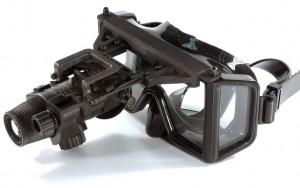
The Closest We Have To Viz Piercing Goggles Is A Normal Mask With Night Vision Strapped On The Front, Not Quite X-Ray, But It’s Getting There…
Final Thoughts
So, there’s my top five wish list of items I’d desperately love to see being prototyped in a few years and commercially available in ten (or sooner…). Most of the items on the list are available in some form or other in different fields and are simply not adapted for underwater applications and other items on my wish list will require quite a bit more research! Either way, I’ll keep watching for new dive products as they appear on the scene, and I’m sure I’ll continue to be amazed at the ingenuity involved in the equipment we are lucky enough to be buying today…remember that today’s commonplace gear was once on a diver’s wish list like this one twenty years ago!
What do you think of my list? Is there anything on it you’d particularly like to see? Do you have a personal gadget or technology that you desperately want dive manufacturers to design? Is there anything that is available today that you once prayed for and are still amazed at (mine is the new DPVs that are on the market – tiny and powerful, the future today!) Please let us know your great ideas in the comment section below.
Happy (futuristic) Bubbles!